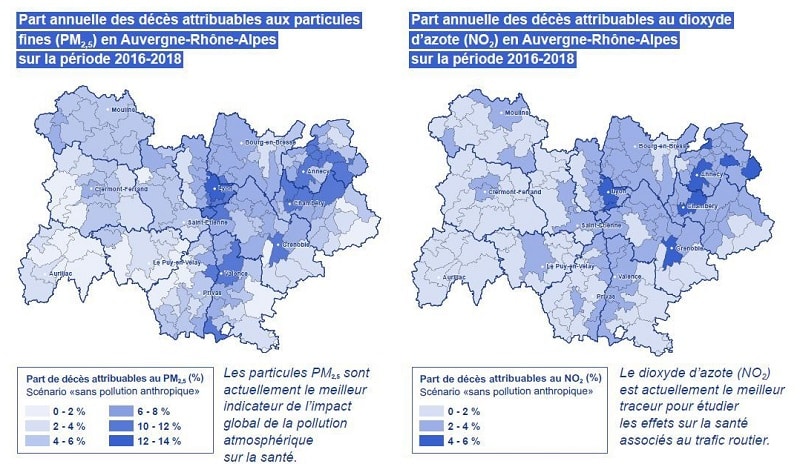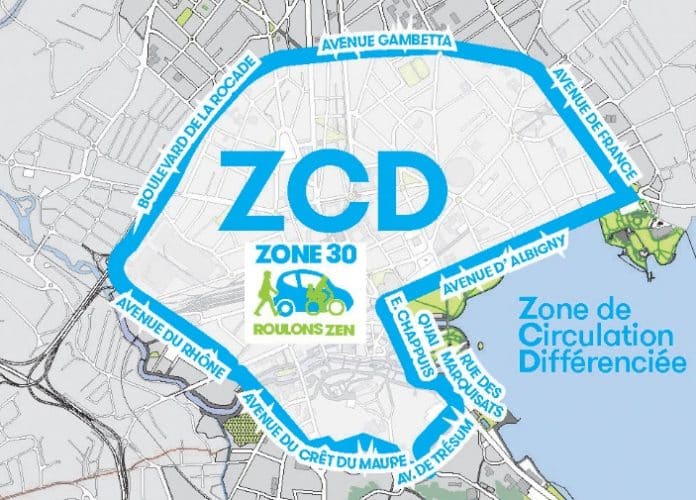The Arve Valley in Haute-Savoie is often singled out for its poor air quality. However, the Annecy basin also appears to be regularly affected by air pollution.
The Auvergne-Rhône-Alpes region strongly affected
A report by Santé Publique France, published on 14 October 2021, stated that exposure to fine particles is the cause of many deaths in the region. The incriminated particles are PM2.5, NO2 and ozone
The cities most affected are Lyon, Grenoble, Chambéry and Annecy. 4,300 deaths per year are attributable to repeated exposure to fine particles. Another 1,960 deaths are linked to nitrogen dioxide (NO2). In these four agglomerations, which are densely populated, 10% of deaths would be caused by these fine particles.

The study indicates that this pollution is caused by human activity. Individual heating, particularly wood heating, is responsible for 67% of these particle emissions. Road traffic accounts for 63% of CO2 emissions, compared with 19% for industry. At national level, 40,000 deaths are attributed to this pollution, which represents 7% of deaths, compared to 10% in our region. However, the document points out that air quality has improved over the last 15 years, even if the consequences on human health remain significant.
A new national air quality index
Since 1 January 2021, the air quality index that measures the level of pollution has evolved, aligning itself with European criteria. It offers several advantages: its daily dissemination is reliable and indisputable. Public authorities can thus take measures to reduce air pollution, such as setting up a differentiated traffic zone. Advice is given to the population to modify their behaviour: speed limits in Annecy, fixed price of the Sibra bus ticket to travel anywhere in the city.
In the region, Atmo Auvergne-Rhône-Alpes (Association Agréée pour la Surveillance de la Qualité de l’Air en Auvergne-Rhône-Alpes) calculates the air quality level. You can, each day, take note of this index below.
This new Atmo index benefits from technological innovation in air sensors. The new equipment makes it possible to measure fine particles 4 times smaller than before.
The devices put in place to fight against pollution
The Differentiated Traffic Zone

If the alert is level 1, only vehicles with the sticker can circulate. For a level 2 alert, only vehicles with a Crit’Air 0, 1, 2 or 3 sticker can circulate. It is the Haute-Savoie prefecture that triggers the ZCD. Currently, it is estimated that 3 days of activation per year are required. When the Atmo index is taken into account, this will rise to 7 to 10 days per year.
How to get a Crit’Air sticker?
The application is made on the government website: certificat-air.gouv.fr with the information from your vehicle registration document. You pay online and receive the sticker by post a few days later. The application can also be made by post by paying by cheque.
Speed reduction in the Arve Valley
Every year, between 1 November and 31 March, the speed limit is reduced in the Arve Valley. The speed limit on the motorway is reduced from 130 to 110 km/h. The RD19 is also affected, as the maximum speed limit is lowered to 90 km/h instead of the usual 110 km/h. Adapting the speed limit is a way of reducing pollutant emissions and ensuring better air quality.
What to do in case of a pollution alert?
In the event of a pollution peak triggered by the prefecture, it is necessary to have the right reflexes. For adults, the following actions are recommended.
- You can go out normally, maintaining low or moderate intensity sports activities.
- Intense physical activities (cross-country running, matches, competitions) should be postponed in the vicinity of the main traffic routes in the Annecy area.
- For people who are sensitive, you should be aware of the following symptoms: fatigue, shortness of breath, coughing or blocked nose.
- It is necessary to continue to air the premises at a rate of 10 mn, twice a day, at the end of the morning in winter and at the beginning of the morning in summer.
- In the event of respiratory discomfort, it should be reported to the care staff.
For infants and children:
- Children’s outings and usual activities should be maintained.
- Infants should not be taken out near major roads in Annecy from 7am to 10am and from 5pm to 8pm.
- Any fatigue, wheezing or sore throat should be monitored.
- The children’s room should be ventilated for 10 minutes, twice a day.
















